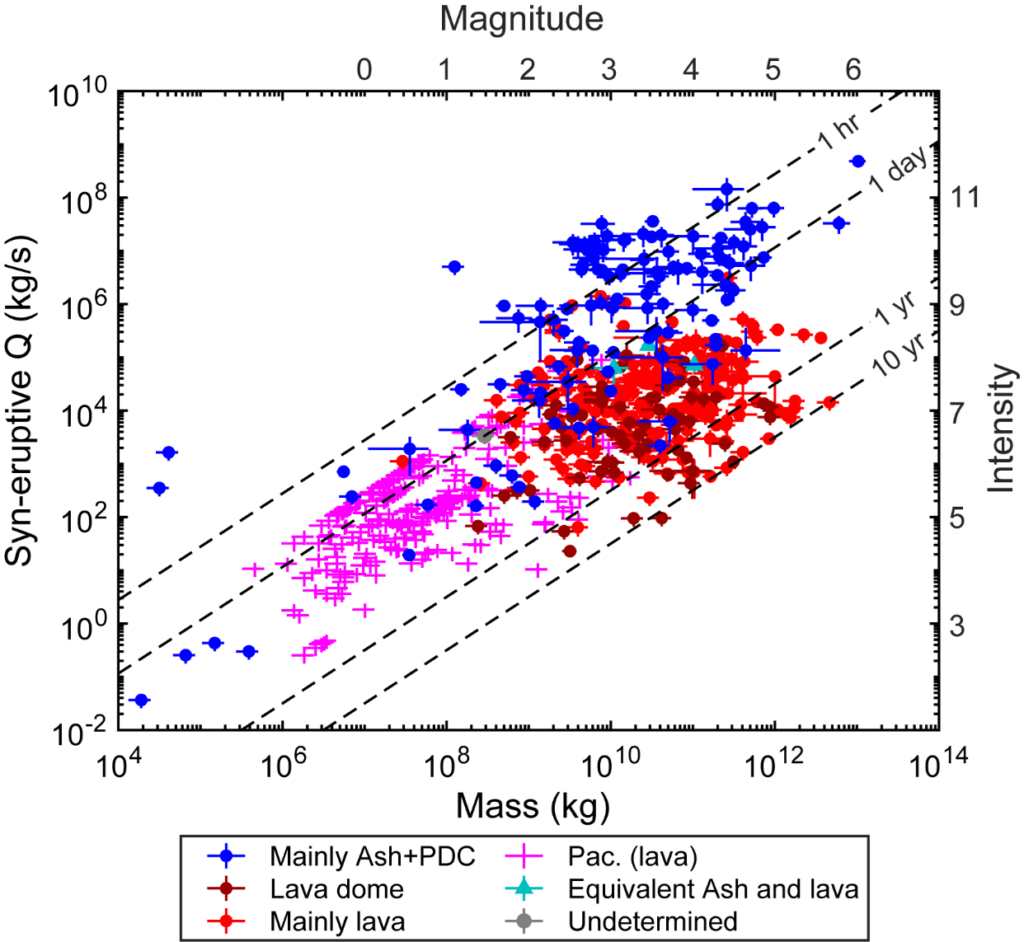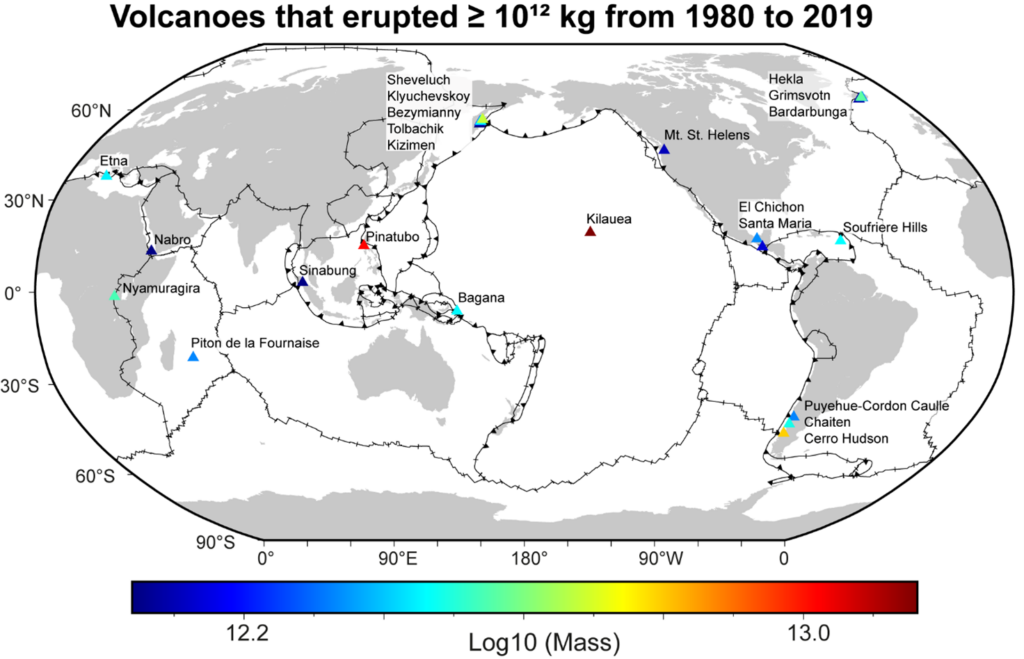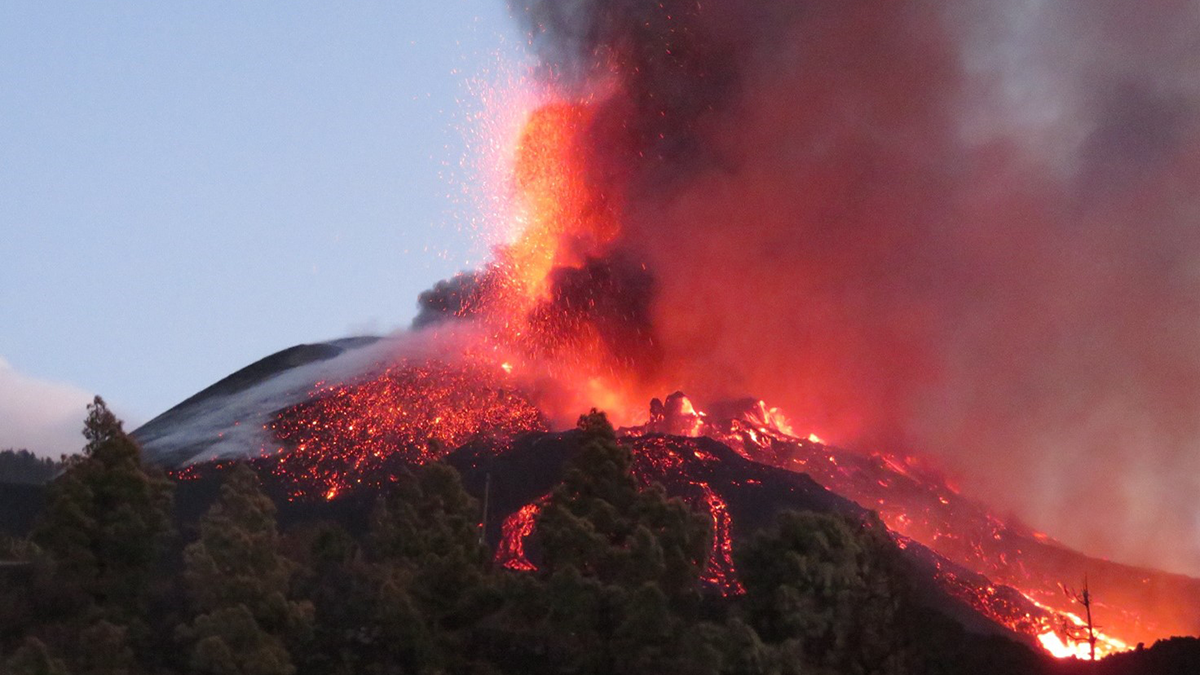Editors’ Vox is a blog from AGU’s Publications Department.
Volcanism is one of the main mechanisms transferring mass between the interior of the Earth and the Earth’s surface. However, the total mass of magma erupted, as well as the mass of each volcanic product, remain poorly constrained both at a global and at a regional scale. A recent study in Reviews of Geophysics quantified the mass of each solid volcanic product erupted above the sea level from 1980 to 2019. We asked the lead author to give an overview of eruption styles and products, explain how our understanding of volcanism is advancing, and outline what opportunities their work opens.
What are the volcanic products erupted by volcanoes and why they are important?
A volcanic eruption can be characterized by the emplacement of lava flows or more viscous lava dome, associated to a non-explosive activity (effusive activity). Otherwise, an eruption can be more explosive, producing fallout deposits (ash and pyroclasts) from the volcanic ash clouds or pyroclastic density current deposits (PDCs) when the eruptive column or flank collapses. The same eruption can produce both effusive and explosive products, usually in different phases of the eruption. Different eruptive styles (effusive and explosive) are associated to different pre-eruptive storage conditions of the magma inside the magma reservoir and to different syn-eruptive processes and, therefore, the kind of product erupted is directly related to the pre- and syn-eruptive processes.
What dataset did you analyze and what did you discover about the type and quantity of products from eruptions?
We used the database of the Smithsonian Global Volcanism Program (GVP VOTW) to identify all the eruptions occurred above sea level from 1980 to 2019 and then we associated to each eruption a range of mass for each product erupted. We found a global volcanic productivity of 1.1-4.9×1013 kilograms of magma per decade from 1980 to 2019 (Figure 1a). Lava is usually the main product (1.7±0.99 x1013kilograms of lava per decade), while the amount of explosive products is about 0.9±0.6 x1013 kilograms of ash + PDC per decade. The occurrence of the biggest explosive eruptions (≥1013 kilograms of magma erupted in a single eruption), which are uncommon, make the global mass of explosive products higher than the global mass of lava, as observed in the decade 1990-1999 due to the 1991 Pinatubo’s eruption (Figure 1a).

What parameters do scientists use to quantify the scale of an eruption?
The two parameters used to quantify the scale of an eruption are the magnitude, that is the mass of material erupted, and the intensity, that is the mass eruption rate. These two parameters are not well-correlated with each other, as the intensity depends on the eruptive style (Figure 2).

How has your work furthered our understanding about volcanic eruptions and eruptive rates?
We compiled a global dataset with the erupted masses for all volcanoes and magmatic provinces that have erupted from 1980 to 2019. This dataset allowed us to calculate for the first time the eruptive rates of many important volcanoes and magmatic province of the world, whose eruptive rates were unknown.
In addition, we were able to investigate how eruptive rates changed in all volcanoes and magmatic provinces that erupted from 1980 to 2019. Changes in the eruptive rates are important since an increase in eruptive rates is usually associated to an increase in the magma supply below the volcano or the magmatic province. Conversely, if eruptive rates decrease, there could be a drop in the magma supply, or only a drop in the erupted mass, with magma continuing to accumulate at depth. Volcanic hazard associated to these two scenarios is opposite, and therefore volcanoes and magmatic provinces experiencing a decrease in the erupted rates should be monitored to understand if they are accumulating magma, which could be released during eruptions, or if they are entering in a quiescent phase.
How has your work furthered our understanding about the global volcanism?
We found that 23 out of 213 volcanoes that erupted from 1980 to 2019 produced about 72% of the total subaerial mass of magma (Figure 3), quantifying the contribution of the most productive volcanoes to the global total erupted mass. In addition, we quantified the influence of the tectonic setting on the type of product (Figure 1b). Indeed, our results highlight how volcanoes placed in divergent margins (rift volcanoes) or above a hot spot produced the 53±0.4% of the subaerial lava erupted worldwide from 1980 to 2019, even though these volcanoes represent only the 14% of the volcanoes that have erupted in this time span. On the contrary the 95±1% of the mass of explosive products erupted worldwide in the investigated time span was erupted by volcanoes placed in convergent margins (arc volcanoes).

How could these data be used for future studies?
Combined with already available datasets, our work furthers future investigations of the relationship between the erupted masses of magma and of volatiles (e.g. SO2 and CO2 released during eruptions), the variation of the eruptive rates after an earthquake, and the impact of the erupted mass (especially the ash) on the Geospheres at local and global scales. Finally, mass balancing between the erupted and intruded mass could provide information of whether a volcano or a magmatic province is accumulating magma, potentially increasing future eruptive hazards on a decadal timescale.
—Federico Galetto ([email protected], ![]() 0000-0001-9469-3968), Cornell University, USA
0000-0001-9469-3968), Cornell University, USA
Editor’s Note: It is the policy of AGU Publications to invite the authors of articles published in Reviews of Geophysics to write a summary for Eos Editors’ Vox.

